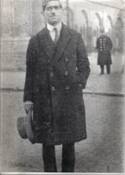British counter-intelligence against the Indian revolutionary movement during World War I
British counter-intelligence against the Indian revolutionary movement during World War I began from its initial roots in the late-19th century and ultimately came to span in extent from Asia through Europe to the West Coast of the United States and Canada.It was effective in thwarting a number of attempts for insurrection in British India during World War I and ultimately in controlling the Indian revolutionary movement both at home and abroad.[10] At the outbreak of the war, Punjab CID sent teams to Hong Kong to intercept and infiltrate the returning Ghadarites, who often made little efforts to hide their plans and objectives.[12] As the date for the mutiny approached, a desperate Rash Behari Bose brought forward the D-day to the evening of 19 February, which was discovered by Kirpal Singh on the very day.Ordered back to his station to signal when the revolutionaries had assembled, Singh was detained by the would-be mutineers, but managed to make good his escape under the cover of answering the call of nature.After the outbreak of the war Wallinger, under the cover of an officer of the British General Headquarters, proceeded to France where he operated out of Paris, working with the French Political Police, the Sûreté.A British agent called Donald Gullick was dispatched to assassinate Virendranath Chattopadhaya while the latter was on his way to Geneva to meet Mahendra Pratap to offer Kaiser Wilhelm II's invitation.It is said that Somerset Maugham, who was in the British Secret Service in Europe during the war, based a number of his stories on his first-hand experiences, modelling the character of John Ashenden after himself and Chandra Lal after Virendranath.[8][20] MI5(g)'s work at the time identified the plans by Ghadar Party and the Berlin Committee to assassinate Lord Kitchener in 1915 through an associate of Har Dayal, Gobind Behari Lal.Among other works, Nathan was responsible for the plans made by British intelligence in late 1915 to assassinate Virendranath Chattopadhyaya through an agent by the name of Donald Gullick.[18] Nathan's work at the time identified the plans by Ghadar Party and the Berlin Committee to assassinate Lord Kitchener in 1915 through an associate of Har Dayal, Gobind Behari Lal.[33] An Irish double agent by the name of Charles Lamb is said to have passed on the majority of the information that compromised the Annie Larsen and ultimately helped the construction of the prosecution.An Indian operative, codenamed "C" and described most likely to have been the adventurous Chandra Kanta Chakravarty (later the chief prosecution witness in the trial), also passed on the details of the conspiracy to British and American intelligence.
a number of attemptsBritish IndiaWorld War IIndian revolutionary movementIndian Political Intelligence OfficeMadan Lal DhingraShyamji Krishna VarmaThe Indian SociologistCurzon WyllieHar DayalHindu–German ConspiracyBengalPunjabanti colonial activitiesBerlin CommitteeGhadar Party1857 uprisingIrish RepublicanSingapore MutinyDefence of India Act 1915W.C HopkinsonDelhi-Lahore ConspiracyKomagata MaruGhadar ConspiracyGerman plotCharles TegartKirpal Singh (spy)Oren (spy)Vincent KraftLiaqat Hayat KhanJugantarJohn WallingerSomerset MaughamTomas MasarykE.V. VoskaVirendranath ChattopadhyaySpecial BranchVernon KellBritish empireRobert NathanBasil ThomsonScotland YardVirendranath ChattopadhayaSecret Service BureauSwitzerlandSûretéMahendra PratapMata HariLord KitchenerGobind Behari LalVirendranath ChattopadhyayaKabul MissionEast Persian CordonSistan provinceSarhadReginald DyerGuy GauntSir William Wiseman, 10th BaronetGhadarW. C. HopkinsonTaraknath DasEast CoastNew York CityGeorge FreemanClan-na-GaelPinkerton'sAnnie Larsen arms plotHindu-German conspiracy trialWilliam WisemanUS State DepartmentBagha JatinHabsburgTomáš MasarykHopkirk, PeterIndian independence movementmilitantBhikaiji CamaIndia HouseAnushilan SamitiAlipore Bomb CaseDelhi ConspiracyHardayalSohan SinghPandurang KhankhojeHindustan GhadarGhadar di gunjGhadar MovementTarak NathGuran DittBaba Gurdit SinghBhagwan SinghBhai ParmanandRam ChandraKartar SinghVishnu PingleKanshi RamAgnes SmedleyChattoChampakA. R. PillaiM. P. T. AcharyaBarkatullahBhupendranath DattaAbhinash BhattacharyaHerambalal GuptaRash BehariSachin SanyalBhavabhushan MitraM. N. RoyPritam SinghAmarendranath ChatterjeeAtulkrishna GhoshDeobandiMahmud al-HasanUbaidullah SindhiMuhammad Mian Mansoor AnsariSufi Amba PrasadTheobald von Bethmann HollwegZimmermannIntelligence Bureau for the EastMax von Oppenheimvon BernstorffGeorge RodiekHentigNiedermayerAnnie Larsen
